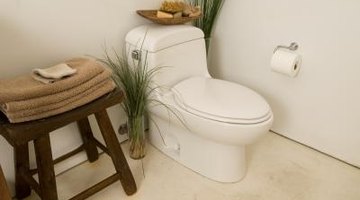Pros & Cons of Toilets
When the mood strikes, locating a toilet is like locating water in the middle of the desert: a total life saver. However, toilets have both their advantages and disadvantages depending on the type and model you use. Maintaining a toilet -- and the drain pipes needed to operate them -- is an essential practice if you want to make the most of the appliance.
Low-Flow

The main advantage of a low-flow toilet is that it uses less water than toilets used to use, conserving water and lowering water bills in the process. On average, a low-flow toilet uses 1.6 gallons of water per flush. Due to the lack of water being used in a low-flow toilet, the water tank is smaller. A smaller toilet takes up less space in your bathroom. However, a low-flow toilet may clog easier than medium to high-flow toilets, especially if large amounts of waste are being flushed at one time. If you have to flush a low-flow toilet repeatedly, you will not conserve as much water.
Incinerating Toilet
The incinerating toilet uses electric heating devices -- located within the base of the unit -- to heat and incinerate your waste into ash. A filter is placed at the base of the toilet to catch your waste. After your business is complete, you press a pedal with your foot that sends your waste -- and filter -- into the heating chamber. The main benefit of this toilet type is that it requires zero water to operate. This will conserve water and reduce your water bills in the long run. However, a constant power source is needed to generate the heat. If your power goes out for an extended period of time, the toilet will not be able to dispose of your waste.
The Portable Toilet
The portable toilet is often used on construction sites and during special events that generate a large group of people, such as music festivals. The main advantage to portable toilets is the convenience. If you work construction, you'll need a place to relieve yourself quickly so that you can continue your work. At festivals and public events, portable toilets are typically the only option to relieve yourself. However, since these toilets are open to the public, you may have to wait a while to use one depending on the size of the line. Not all portable toilets contain sinks, making it impossible to wash your hands after you go. Despite efforts, portable toilets are not nearly as clean as personal bathrooms. If toilet seat guards are absent, you may be hesitant to sit on the seat.
In General
While toilets within a home make waste disposal rather convenient, they do not always work properly. For example, if a child accidentally -- or purposely -- flushes a toy down the toilet, a clog can result. Septic tanks can overflow, toilet handles can break, and water levels can rise, causing an overflow if the drain has a blockage. Using a plunger can resolve small clogs, and an auger -- a drain cleaning tool -- can be used to clear bigger clogs. As with any appliance, a toilet must be taken care of to be used properly. Serious problems may require a professional plumber, which can become costly if problems continue to develop.
References
Resources
Writer Bio
Based in California, Noel Shankel has been writing and directing since 2002. His work has been published in "Law of Inertia Magazine." Shankel has a Bachelor of Arts in film and writing from San Francisco State University.
Photo Credits
- Jupiterimages/Photos.com/Getty Images
More Articles



